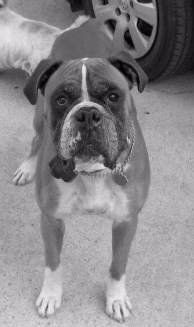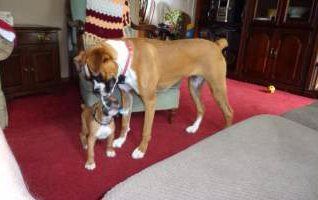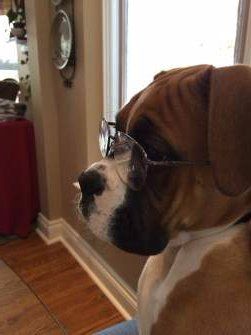Boxer Dog Calorie Requirements
Overview
Undoubtedly, you put a lot of effort in making sure that your Boxer has high quality meals and healthy snacks and while you may be spot on in what you feed him/her, you may wonder if your puppy or dog is actually receiving enough calories.
Owners of Boxer puppies want to make sure that the pup has the proper calorie intake for a growing body. Adolescent Boxer dogs may have a skinny phase that prompts owners to wonder about this. For adults, being on point in regard to food is important to maintain proper weight and for seniors, owners wonder if metabolism and activity changes equal fewer calories per day.
In this section we will cover:
- The 5 factors that affect calorie requirements
- How many calories a Boxer dog needs in each stage of life
- Do owners need to pay attention to their Boxer's calorie intake?
- Comparison of calories in different types of dog food
- Making adjustments -Both higher and lower
What Affects Calorie Needs for Boxer Dogs

Titus, 5 months old
Photo courtesy of Ash & Ronnie
It's important to understand that there are quite a few things that play a significant role in how many calories a dog requires. There are 5 main elements to consider:
Age -
While Boxer puppies will eat less than adults due to size, puppies require more calories per pound of body weight to compensate for the rapid growth that is underway.
In addition, metabolism is high. Up until the age of 2 years old, there can be times of growth spurts, which necessitates a bump in calories (and even so, some Boxers can't keep up, more ahead). With seniors, there is a gradual slowing down in metabolism and activity that also requires a change.
Weight
- The size of your Boxer dog will be one of the most significant elements in regard to how many calories the dog needs. The larger the body, the more energy (calories) are needed. Even when sedentary, the body is using energy to function… to breath, circulate blood, etc.
Activity Level
- While one important factor that affects calorie needs will be exercise that raises the heartbeat (walks, runs, playing fetch, etc.) yet another element is NEAT (Non-Exercise Activity Thermogenesis).
If you had two Boxer dogs of the exact same age, weight, height and health status, but one of them moved around a lot (paced, played with other dogs, moved from room to room, etc.) and the other simply rested in place, that first dog would burn up to 200 additional calories per day.
Muscle ratio
- While not the #1 factor, the amount of muscle that a dog has does play a part in how many calories his body needs to function. And the more that muscled dog stays active, the further this contributes to this. Muscles require more calories to be maintained than fat.
With Boxer dogs that are in shape with good muscle definition, the resting energy expenditure is going to be higher than Boxers that are out-of-shape.
Health status
- Pregnant and lactating dogs will have a gradual rise in calorie requirements throughout the 63 days of gestation with a need for increased protein and healthy fats to ensure proper growth of the fetuses. While illness and health conditions have only a negligible effect on a dog's metabolism, dogs that are dealing with health issues
may be less active, which means few calories are needed to maintain. Alternatively, dogs that are in discomfort often have a decreased appetite, which can make it hard for the dog to eat as much as needed.
Does a Neutered or Spayed Boxer Dog need fewer calories?
This is an exceedingly common question, due mostly in part to myths spread among sources that repeat the same, outdated information over and over. Neutering or spaying does not affect metabolism and therefore caloric intake needs do not change at all. Nor does it cause dogs to be lazy.
It does, however, affect behavior that in turn
may change how much a dog needs to eat. Dogs that are fixed no longer have urges to mate and this goes for both males and females. For some dogs, this can equate to a difference in activity. For example, super revved up dogs looking for other dogs to mate with, that constantly paced the yard or ran back and forth at the window will often be much calmer after the procedure and over time, that could affect the energy output of the dog and therefore calorie needs.
How Many Calories a Boxer Dog Needs
As we go over this, do keep in mind all of the factors that play a role in how many calories are needed for a dog's body to function.
As you can imagine, it is not possible to give a specific number that would apply to each individual Boxer since requirements are going to vary quite a bit depending on age, size, activity level, NEAT and even muscle to fat ratio.
For this reason, there is a range that you can refer to.
Boxer puppies
- As a general guideline, growing Boxer puppies
need 55 calories for each pound of body weight. This is taking into consideration that puppies sleep quite a bit and are typically very active when they are awake.
Since it is normal for puppies to have starts and spurts of growth rather than linear development, technically this number will fluctuate from month to month.
Here are the values:
Weight 5 lbs. (2.26 kg) = approx. 275 calories
Weight 10 lbs. (4.53 kg = approx. 550 calories
Weight 15 lbs. (6.80 kg) = approx. 825 calories
Weight 20 lbs. (9.07 kg) = approx. 1100 calories
Weight 25 lbs. (11.33 kg) = approx. 1375 calories
Weight 30 lbs. (13.60 kg) = approx. 1650 calories

Rue La La (aka) Rucy, 4 years old
Photo courtesy of Jimmie McKenzie
*These numbers can fluctuate by 20% either up or down. More ahead regarding how much importance should be placed on calorie counting.
Adolescent Boxers / Young Adults- It is not uncommon for this breed to have a very pronounced adolescent stage that begins toward during the end of the puppy phase and continues on, dipping into adulthood.
During the time of 18 months (though sometimes starting as young as 14 months) to roughly 24 months (and in some cases beyond this to up to 2 and 1/2 years), a Boxer dog may struggle to keep up his weight. With these dogs, they have a hard time eating enough calories to keep up with the demands of a rapidly changing and maturing body.
This is a temporary phase at which time a Boxer dog will look too skinny
and once height is established, the body will begin to fill out. Ribs that were visible will gradually become padded with muscle and fat, giving the dog a healthier, strong appearance.
The tricky part about this in regard to calorie requirements is that the 55 calories per pound of body weight may need to be ticked up a bit and then maintained once the Boxer reaches the 2 year mark instead of lowering calories as per adult feeding guidelines.
Adult Boxer Dogs
- On average, an adult Boxer dog that meets his exercise requirements of 1 to 2 walks per day, plus play sessions requires anywhere from 25 to 35 calories per pound of body weight. As with all life stages, there is a variance of 20% up or down from this number.
Here are the general guidelines based on weight:
Weight 50 lbs. (22.67 kg) = 1250 to 1750 calories
Weight 55 lbs. (24.94 kg) = 1375 to 1925 calories
Weight 60 lbs. (27.21 kg) = 1500 to 2100 calories
Weight 65 lbs. (29.48 kg) = 1625 to 2275 calories
Weight 70 lbs. (31.75 kg) = 1750 to 2450 calories
Weight 75 lbs. (34.01 kg) = 1875 to 2650 calories

Rowdy (at 12 years old)
Photo courtesy of Brandi Lavender
Senior Boxer Dogs
- There are seniors that show their age and some that appear to be as active and energetic as ever, so of course this plays a significant role in how many calories the dog needs to maintain weight.
Requirements do not change overnight; it is a very gradual process due to a slight slowing down that owners may not even be aware of.
Issues such mild arthritis often led to a dog walking a tad slower and perhaps signaling that he is done playing a bit earlier than when he was younger.
Typically, this won't be noticed right away. It is often 2 or even 3 years after changes begin that there is enough of a difference for owners to take note. And in some cases, there will be a slight weight increase combined with decreased muscle mass that is just enough for owners to wake up one day and exclaim, "When did my Boxer gain weight and get out of shape!"
So, being aware that the older, senior Boxer dog
needs slightly less calories than his younger counterparts is something to be aware of. Most senior dogs will be on the lower end of the 25 to 30 calories per pound of body weight.
Those suffering with health issues that prevent regular exercise
still need at least 25 calories per pound for the body to maintain all necessary functions and to receive needed protein, carbs, healthy fats, vitamins and minerals.
While you do not need to meticulously count calories (more ahead) it's a good idea to know that from the age of 8 or 9 and into the teens, your Boxer would do best with some lower calorie options in place of some high caloric content. And we will provide further information on this coming up in this article.
How Important is Monitoring Calorie Intake?
While many owners want to know their dog's calorie needs simply to beware of the number, there are many elements that are much more important than just calories.
Let's look at other factors to consider:
1) Quality-
1000 calories of junk (filler food) vs 1000 calories of wholesome ingredients (fresh meat, vegetable and fruits) is as different as day and night. You can never meet nutritional needs based solely on calories.
If a Boxer dog were to ingest 1000 calories of low-quality, manufactured food with cheap fillers such as peanut hulls and modified corn starch (the canine equivalent of human junk food), there would be very few nutrients for his body to absorb. Any extra carbs would be packed on as fat and super cheap ingredients would pass through the body, come out the other end and do nothing to keep the dog's energy level high.
Alternatively, if a Boxer dog were to ingest 1000 calories of wholesome ingredients such as white breast chicken meat (protein), sweet potatoes (carbs) and blueberries (sugar, carbs, fiber), his body would draw on all of those, making good use of them. Protein is essential for maintaining and building bones, muscles, cartilage and skin. The healthy carbs would fuel the body and the blueberries would offer a high packed punch of antioxidants.
Hopefully, most owners will fall into the middle ground of this. If you can't home cook and you offer commercial food, have it be filler-free. Avoid artificial coloring, preservatives and flavoring which can wreak havoc due to allergy sensitives. Look for a quality brand that offers 'real' foods such as chicken, veggies and fruit without fillers that unnecessarily pad the meals with garbage that passes through the body, offering a temporary fullness without any nutrients.
We recommend Orijen, a 5 star dog food that is considered one of the best.
2) Measuring Calories -
There is fundamentally no method of offering how many calories are in one cup of 'basic' dog food. It varies widely according to commercial vs homemade, wet vs dry, high quality vs medium quality vs low quality.
Let's look at the calories found in dog food, depending on the type and quality:
- Commercial high quality dry (Orijen adult dog): 478 calories per cup
- Commercial medium quality dry (Eukanuba Adult Maintenance formula): 346.77 calories per cup.
- Commercial low quality dry (Alpo Adult Come ‘n Get It Mixed Grill): 375 calories per cup
- Commercial high quality wet (Abound Grain Free Turkey & Sweet Potato): 343 in a 13.2 oz. can (25.9 calories per ounce)
- Commercial medium quality wet (Blue Home Style Chicken w/ Vegetables): 455 in a 12.5 oz. can (36.4 per ounce)
- Commercial low quality wet (Alpo Prime Cuts Beef and Rice): 342 calories in a 13.2 oz. can (25.9 per ounce)
- Home cooked food (6 oz. white breast chicken meat, 1/2 cup sweet potato, 1/2 cup carrots, 2 tablespoons whole white yogurt, 1/4 cup blueberries and raspberries): 530 calories
So, as you can see, trying to figure out how much quantity your Boxer needs based on cups varies wildly depending on the type of food. Once you factor in snacks, you'll drive yourself bonkers trying to keep track of it all.
And that brings us to #3:
3) The best way
to know if your Boxer is eating enough is to feed him according to the recommendations on the packaging and to keep track of weight.
Puppies of course should be growing. While we know you want specifics, how much a puppy gains each week or month fluctuates quite a bit. In a rapid growth spurt, a Boxer puppy can gain 5 lbs. in one week; during a pause, it may be .5 lbs.
Weight gains will gradually slow as the Boxer reaches 1 the year mark and then will slow even further (yet there will be growth up until 2 years old and some filling out up until 3).
From 14 to 30 months, a Boxer may be a bit behind in weight as he eats to catch up to his/her adult height. Adult Boxer dogs, once they have filled out in the chest, should be maintaining. Seniors may gain a few pounds but essentially should be maintaining.
Your vet is the best source to let you know if your Boxer is at a healthy weight
based on age and bone structure and if there is a need to increase or decrease calories.
There is no need to be fanatical when it comes to calories. It is MUCH more important to focus on feeding your Boxer the best food possible. Have your goal be to keep your Boxer dog at a good weight and with plenty of energy. The only time to be concerned about calorie is if the dog is overweight (more ahead).
Lowering Calories for an Overweight Boxer
First, you'll want to make an appointment with the vet to 1) Confirm that the dog is indeed overweight and 2) Have tests run to determine if this is due to a health issue. While many health issues will cause weight loss, some will cause weight gain. Most notably would be a thyroid disorder; though in some rare cases diabetes can cause this as well.
If it has been confirmed that your Boxer needs to lighten his load a bit and has been deemed healthy enough for a change, the best method is to slightly increase activity along with lowering calories consumed. Fortunately, there is a way to do this without changing the amount of food that the dog eats, since most will find smaller portions to be upsetting.
The idea is rather basic, yet effective…. You'll want to switch out higher caloric content for lower calorie options. You'll remove some of the dog's regular food
and mix in low calorie ingredients to keep the serving size the same.
Some great options include:
Veggies
These are good choices due to low calories per volume. They can plump up meals, allowing your Boxer dog to eat a good amount of food while keeping calories low.
- Green beans - This is a low sodium food loaded with vitamins, most notably C and A. 1/2 cup has only 17 calories.
- Carrots - Considered to be one of the world's healthiest foods, 1/2 cup of sliced carrots has only 26 calories. It's an antioxidant vegetable with beta-carotene for good vision, eye health and a strong immune system.
- Bell peppers - This is a great food to give to Boxers that need to trim down. These are super tasty and wicked low in calories. A medium bell peppers has only 24 calories and contains vitamins including A, B6 and C.
Fruits
It's always a great idea to add some fresh fruit to a Boxer dog's diet, even if he/she is at an ideal weight. Many are packed with water, which helps keep the dog hydrated and can be a much healthier alternative than manufactured treats. If your training your Boxer puppy for housebreaking
or working with a Boxer on commands or heeling, you'll find that some frozen fruit pieces are highly motivating.
- Berries - Blueberries and raspberries are super good fruits to add to meals or to offer as treats. Frozen berries are easy to dispense when training and these offer a nice sweet addition to plump up meals, offering low calories to replace higher calorie foods. In addition, the antioxidant qualities of berries are amazing.
Eaten on a regular basis, these can ward off cancer and many other health issues. A 1/2 cup of blueberries is 42 calories (with 85% water per volume) and raspberries are even less with only 32 calories (with 87% water per volume).
- Cantaloupe - This is a very flavorful, low calorie food with several antioxidants. Water content is 97%, which is great for dogs that need calorie restrictions and a 1/2 cup diced has a mere 26 calories.
- Watermelon - This super sweet fruit is perfect for both helping a Boxer dog reach his daily water requirements, as well as offering a super low calorie food. Just be sure to offer the seedless variety to prevent possible blockage. A cup of this diced is just 46 calories.

Smoky (one year old) & Maggie (1 year, 10 months)
Photo courtesy of C. Jay Holzshu Jr.
Increasing Calories to Help a Boxer Dog Gain Weight
Before you make any changes to your Boxer's diet, you'll want to have him/her examined by the veterinarian.
Weight loss or inability to gain weight can be due to an underlying health condition. A complete blood count must be done, along with a urinalysis and a stool sample. The list of diseases and illness that can be at the route of this problem are many; some common issues include parasites, intestinal disorders, bowel disease, stomach or intestinal obstruction and diabetes.
If your Boxer's has been examined and if found to be 100% healthy and this is just a matter of 'fattening up the dog', there are ways that this can be done. First, it may simply be a matter of the dog having grown and needing larger servings for meals and/or more supplementary snacks.
If this does not do the trick, the goal will be to offer calorie dense foods. Since this breed is prone to bloat, while you can offer more food per serving if needed, you will not want to increase food too rapidly. Eating too much or too fast can cause stomach distortion.
Boxer dogs gain weight best (and the right way) when given protein rich foods. After all, you don't really want a 'fat' dog, you want your Boxer to beef up! You'll want to start with a goal of adding 200 calories per day, taking 2 weeks to look for improvement. Some great additions (to add to meals or give as snacks) include:
- Sardines- Don't go overboard with these, however sardines packed in olive oil are filled with both healthy fats and tons of protein. Just 2 sardines are 50 calories… mix 4 into your Boxer's dinner and you've just added 100 calories to his daily total.
- White, water-packed tuna - While you can go the route of oil packed, this should be avoided if you offer sardines or if you plan on mixing tuna into meals each day. Just one can divvied up over the course of the day adds 190 calories and 42 grams of protein.
- Cottage cheese - This is a great food to give to Boxers that have upset stomachs, but is also a good choice if you want to add more calories to a dog's daily intake without over-stuffing him.1/2 cup has 110 calories. Mix it into kibble and most dogs love the flavor.
- Eggs - You can quickly scramble up an egg or two to add to meals or boil a few to give out as snacks. Most adult Boxers will chew down an egg with one bite and that adds 70 calories and a good boost of protein (6 grams) to his daily intake.
- Peanut butter - Owners of Boxers with separation anxiety know the benefits of peanut butter as a Kong stuffer to keep dogs busy and those with teething puppies also realize how great this nutty spread can be to encourage pups to chew on toys and not shoes… or chair legs… or your favorite magazine that you left out on the coffee table… or your wallet… or, well, you know Boxers, they are exceedingly curious and will mouth just about anything! But peanut butter is also calorie dense and offers healthy fats (heart-healthy monounsaturated fat). Just one tablespoon has 95 calories.
The Bottom Line
While it's a good idea to have a basic understanding of how many calories your Boxer puppy, adult or senior dog needs to have, it is better to focus on quality meals and snacks, keeping an eye on your Boxer's weight as your guideline to how he is growing or maintaining.

